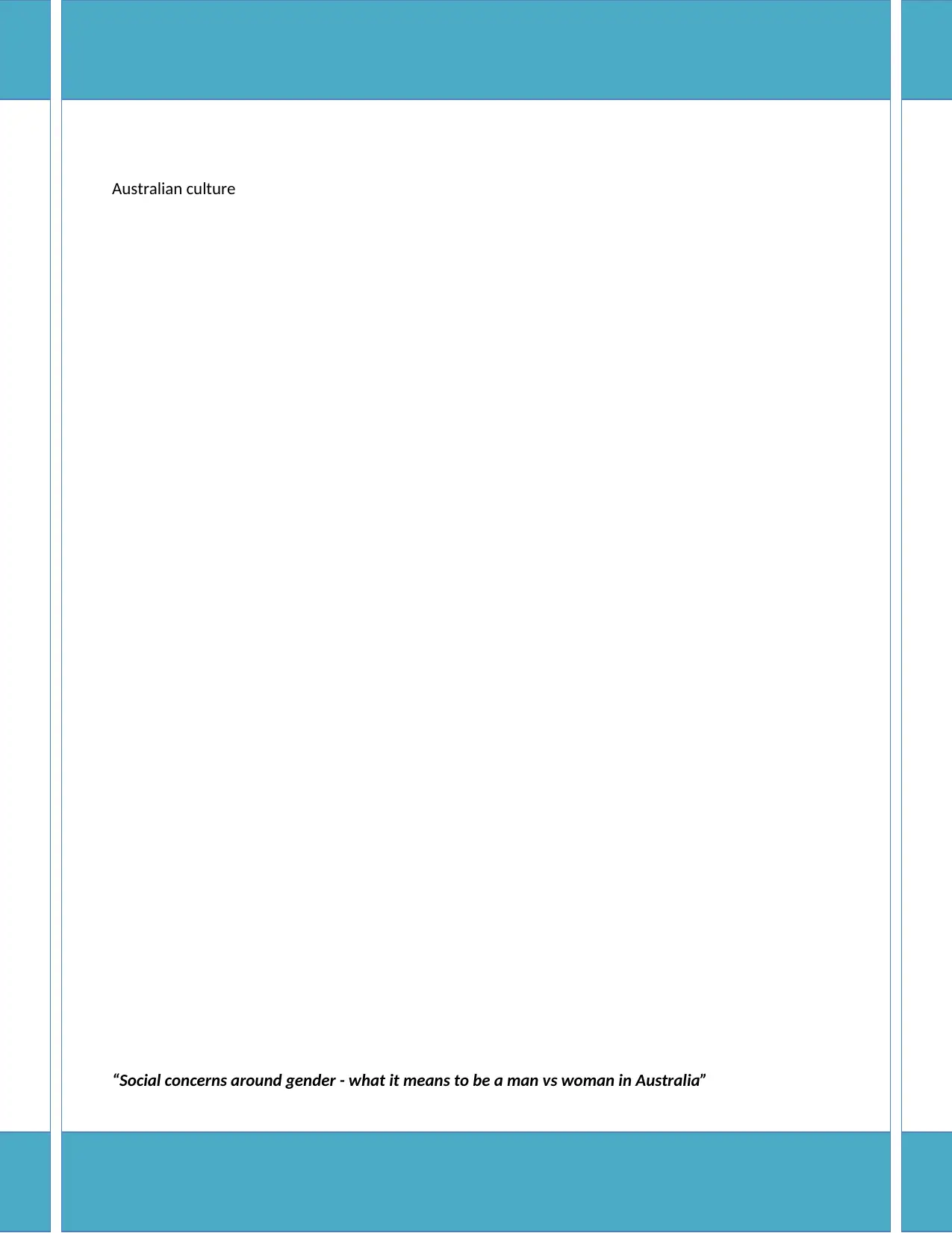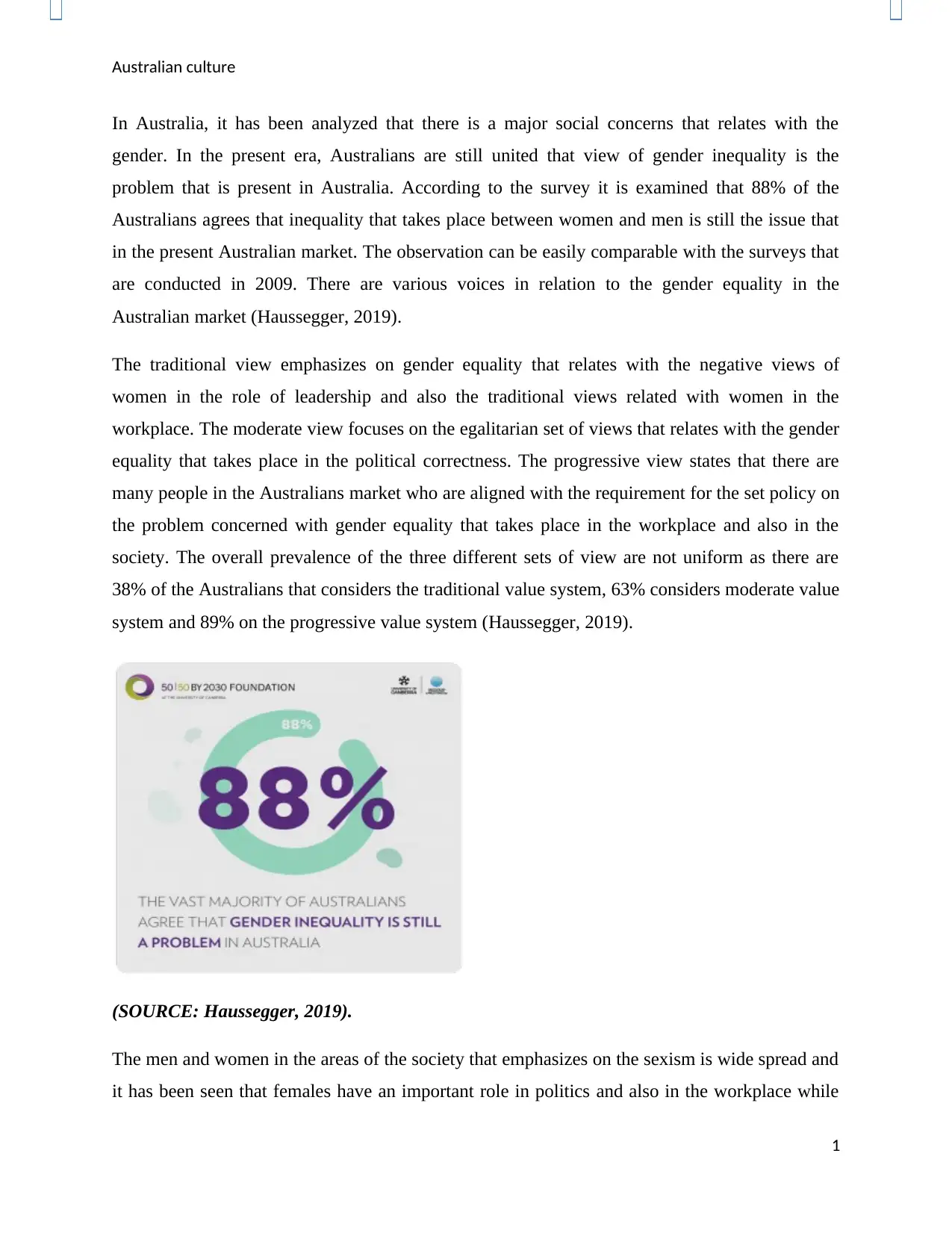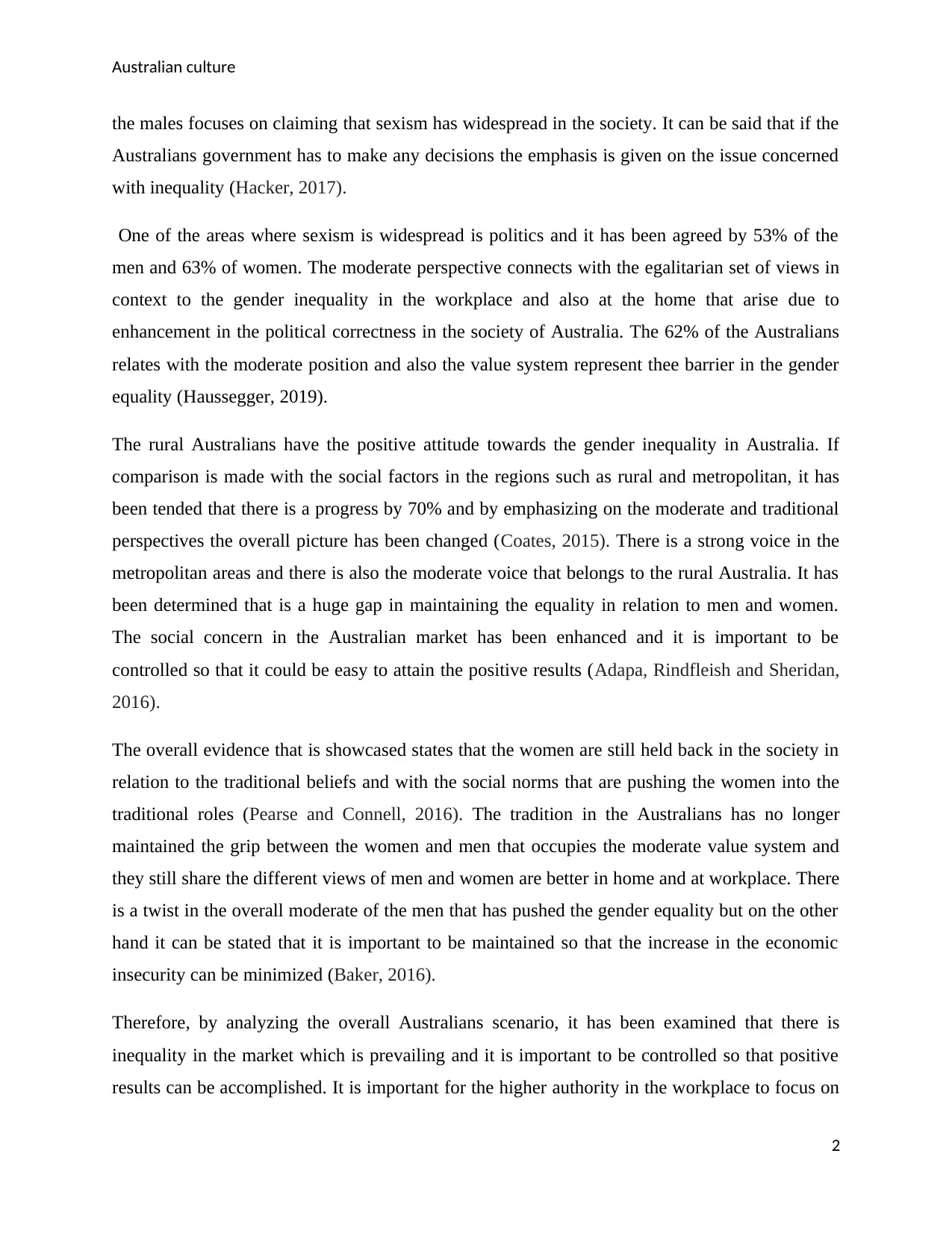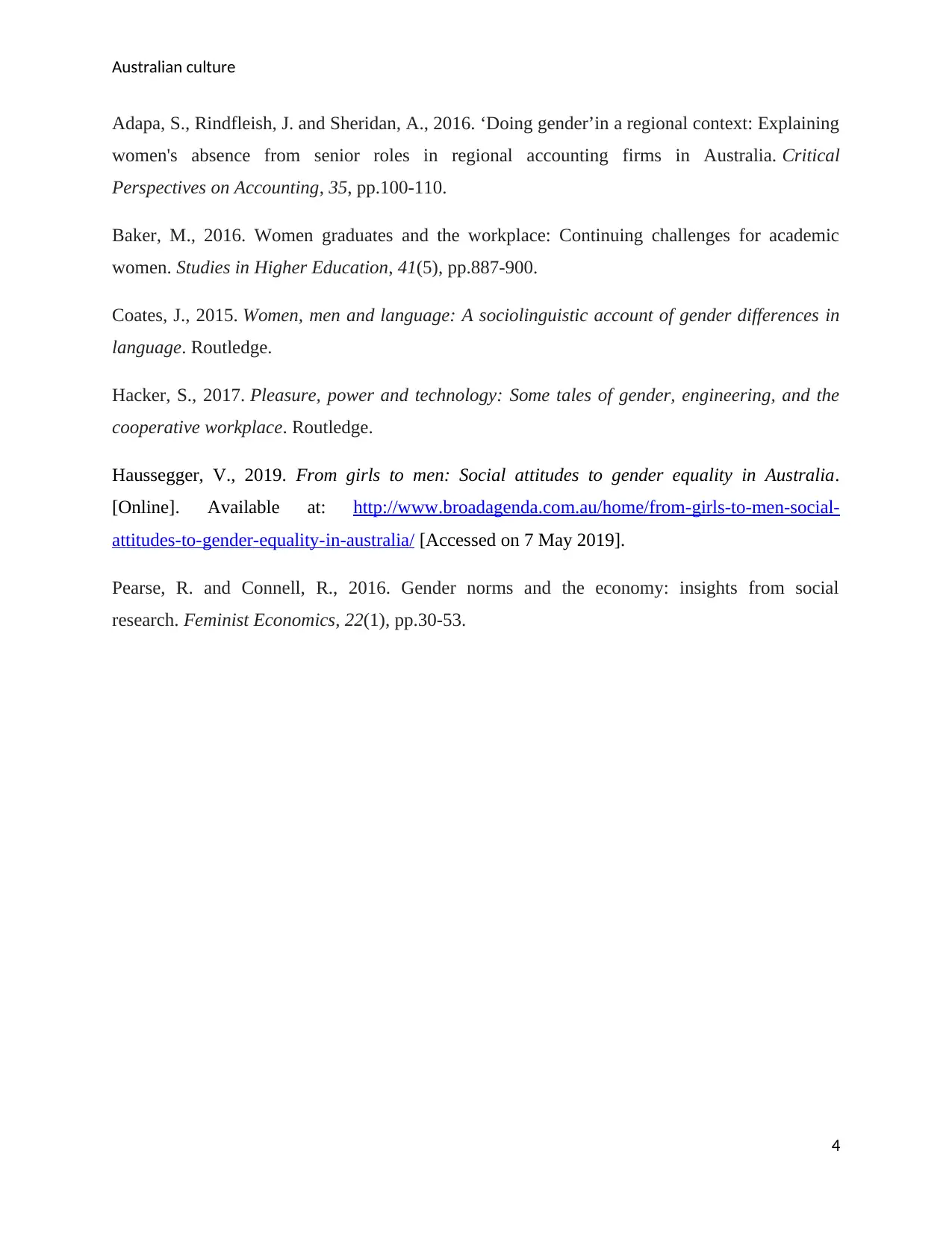Exploring Social Concerns Around Gender in Australian Culture
VerifiedAdded on 2023/03/17
|5
|1048
|54
Essay
AI Summary
This essay provides an analysis of gender inequality within Australian culture, highlighting the prevalent social concerns surrounding the roles of men and women. It examines the differing perspectives on gender equality, including traditional, moderate, and progressive viewpoints, and explores how these views impact the workplace and political spheres. The essay references survey data indicating that a significant portion of Australians still perceive gender inequality as a major issue. It also discusses the influence of social norms and values, particularly in rural versus metropolitan areas, and the impact of these factors on women's advancement in society. The author emphasizes the need for greater efforts to address gender-based disparities and promote equal opportunities for both men and women to foster a more equitable environment.

Australian culture
“Social concerns around gender - what it means to be a man vs woman in Australia”
“Social concerns around gender - what it means to be a man vs woman in Australia”
Paraphrase This Document
Need a fresh take? Get an instant paraphrase of this document with our AI Paraphraser

Australian culture
In Australia, it has been analyzed that there is a major social concerns that relates with the
gender. In the present era, Australians are still united that view of gender inequality is the
problem that is present in Australia. According to the survey it is examined that 88% of the
Australians agrees that inequality that takes place between women and men is still the issue that
in the present Australian market. The observation can be easily comparable with the surveys that
are conducted in 2009. There are various voices in relation to the gender equality in the
Australian market (Haussegger, 2019).
The traditional view emphasizes on gender equality that relates with the negative views of
women in the role of leadership and also the traditional views related with women in the
workplace. The moderate view focuses on the egalitarian set of views that relates with the gender
equality that takes place in the political correctness. The progressive view states that there are
many people in the Australians market who are aligned with the requirement for the set policy on
the problem concerned with gender equality that takes place in the workplace and also in the
society. The overall prevalence of the three different sets of view are not uniform as there are
38% of the Australians that considers the traditional value system, 63% considers moderate value
system and 89% on the progressive value system (Haussegger, 2019).
(SOURCE: Haussegger, 2019).
The men and women in the areas of the society that emphasizes on the sexism is wide spread and
it has been seen that females have an important role in politics and also in the workplace while
1
In Australia, it has been analyzed that there is a major social concerns that relates with the
gender. In the present era, Australians are still united that view of gender inequality is the
problem that is present in Australia. According to the survey it is examined that 88% of the
Australians agrees that inequality that takes place between women and men is still the issue that
in the present Australian market. The observation can be easily comparable with the surveys that
are conducted in 2009. There are various voices in relation to the gender equality in the
Australian market (Haussegger, 2019).
The traditional view emphasizes on gender equality that relates with the negative views of
women in the role of leadership and also the traditional views related with women in the
workplace. The moderate view focuses on the egalitarian set of views that relates with the gender
equality that takes place in the political correctness. The progressive view states that there are
many people in the Australians market who are aligned with the requirement for the set policy on
the problem concerned with gender equality that takes place in the workplace and also in the
society. The overall prevalence of the three different sets of view are not uniform as there are
38% of the Australians that considers the traditional value system, 63% considers moderate value
system and 89% on the progressive value system (Haussegger, 2019).
(SOURCE: Haussegger, 2019).
The men and women in the areas of the society that emphasizes on the sexism is wide spread and
it has been seen that females have an important role in politics and also in the workplace while
1

Australian culture
the males focuses on claiming that sexism has widespread in the society. It can be said that if the
Australians government has to make any decisions the emphasis is given on the issue concerned
with inequality (Hacker, 2017).
One of the areas where sexism is widespread is politics and it has been agreed by 53% of the
men and 63% of women. The moderate perspective connects with the egalitarian set of views in
context to the gender inequality in the workplace and also at the home that arise due to
enhancement in the political correctness in the society of Australia. The 62% of the Australians
relates with the moderate position and also the value system represent thee barrier in the gender
equality (Haussegger, 2019).
The rural Australians have the positive attitude towards the gender inequality in Australia. If
comparison is made with the social factors in the regions such as rural and metropolitan, it has
been tended that there is a progress by 70% and by emphasizing on the moderate and traditional
perspectives the overall picture has been changed (Coates, 2015). There is a strong voice in the
metropolitan areas and there is also the moderate voice that belongs to the rural Australia. It has
been determined that is a huge gap in maintaining the equality in relation to men and women.
The social concern in the Australian market has been enhanced and it is important to be
controlled so that it could be easy to attain the positive results (Adapa, Rindfleish and Sheridan,
2016).
The overall evidence that is showcased states that the women are still held back in the society in
relation to the traditional beliefs and with the social norms that are pushing the women into the
traditional roles (Pearse and Connell, 2016). The tradition in the Australians has no longer
maintained the grip between the women and men that occupies the moderate value system and
they still share the different views of men and women are better in home and at workplace. There
is a twist in the overall moderate of the men that has pushed the gender equality but on the other
hand it can be stated that it is important to be maintained so that the increase in the economic
insecurity can be minimized (Baker, 2016).
Therefore, by analyzing the overall Australians scenario, it has been examined that there is
inequality in the market which is prevailing and it is important to be controlled so that positive
results can be accomplished. It is important for the higher authority in the workplace to focus on
2
the males focuses on claiming that sexism has widespread in the society. It can be said that if the
Australians government has to make any decisions the emphasis is given on the issue concerned
with inequality (Hacker, 2017).
One of the areas where sexism is widespread is politics and it has been agreed by 53% of the
men and 63% of women. The moderate perspective connects with the egalitarian set of views in
context to the gender inequality in the workplace and also at the home that arise due to
enhancement in the political correctness in the society of Australia. The 62% of the Australians
relates with the moderate position and also the value system represent thee barrier in the gender
equality (Haussegger, 2019).
The rural Australians have the positive attitude towards the gender inequality in Australia. If
comparison is made with the social factors in the regions such as rural and metropolitan, it has
been tended that there is a progress by 70% and by emphasizing on the moderate and traditional
perspectives the overall picture has been changed (Coates, 2015). There is a strong voice in the
metropolitan areas and there is also the moderate voice that belongs to the rural Australia. It has
been determined that is a huge gap in maintaining the equality in relation to men and women.
The social concern in the Australian market has been enhanced and it is important to be
controlled so that it could be easy to attain the positive results (Adapa, Rindfleish and Sheridan,
2016).
The overall evidence that is showcased states that the women are still held back in the society in
relation to the traditional beliefs and with the social norms that are pushing the women into the
traditional roles (Pearse and Connell, 2016). The tradition in the Australians has no longer
maintained the grip between the women and men that occupies the moderate value system and
they still share the different views of men and women are better in home and at workplace. There
is a twist in the overall moderate of the men that has pushed the gender equality but on the other
hand it can be stated that it is important to be maintained so that the increase in the economic
insecurity can be minimized (Baker, 2016).
Therefore, by analyzing the overall Australians scenario, it has been examined that there is
inequality in the market which is prevailing and it is important to be controlled so that positive
results can be accomplished. It is important for the higher authority in the workplace to focus on
2
⊘ This is a preview!⊘
Do you want full access?
Subscribe today to unlock all pages.

Trusted by 1+ million students worldwide

Australian culture
giving equal chance to the women and men so that the ratio in context to gender equality can be
minimized. So, it can be stated that if the social concerns relates with gender is minimized then it
would be easy to maintain the positive environment.
References
3
giving equal chance to the women and men so that the ratio in context to gender equality can be
minimized. So, it can be stated that if the social concerns relates with gender is minimized then it
would be easy to maintain the positive environment.
References
3
Paraphrase This Document
Need a fresh take? Get an instant paraphrase of this document with our AI Paraphraser

Australian culture
Adapa, S., Rindfleish, J. and Sheridan, A., 2016. ‘Doing gender’in a regional context: Explaining
women's absence from senior roles in regional accounting firms in Australia. Critical
Perspectives on Accounting, 35, pp.100-110.
Baker, M., 2016. Women graduates and the workplace: Continuing challenges for academic
women. Studies in Higher Education, 41(5), pp.887-900.
Coates, J., 2015. Women, men and language: A sociolinguistic account of gender differences in
language. Routledge.
Hacker, S., 2017. Pleasure, power and technology: Some tales of gender, engineering, and the
cooperative workplace. Routledge.
Haussegger, V., 2019. From girls to men: Social attitudes to gender equality in Australia.
[Online]. Available at: http://www.broadagenda.com.au/home/from-girls-to-men-social-
attitudes-to-gender-equality-in-australia/ [Accessed on 7 May 2019].
Pearse, R. and Connell, R., 2016. Gender norms and the economy: insights from social
research. Feminist Economics, 22(1), pp.30-53.
4
Adapa, S., Rindfleish, J. and Sheridan, A., 2016. ‘Doing gender’in a regional context: Explaining
women's absence from senior roles in regional accounting firms in Australia. Critical
Perspectives on Accounting, 35, pp.100-110.
Baker, M., 2016. Women graduates and the workplace: Continuing challenges for academic
women. Studies in Higher Education, 41(5), pp.887-900.
Coates, J., 2015. Women, men and language: A sociolinguistic account of gender differences in
language. Routledge.
Hacker, S., 2017. Pleasure, power and technology: Some tales of gender, engineering, and the
cooperative workplace. Routledge.
Haussegger, V., 2019. From girls to men: Social attitudes to gender equality in Australia.
[Online]. Available at: http://www.broadagenda.com.au/home/from-girls-to-men-social-
attitudes-to-gender-equality-in-australia/ [Accessed on 7 May 2019].
Pearse, R. and Connell, R., 2016. Gender norms and the economy: insights from social
research. Feminist Economics, 22(1), pp.30-53.
4
1 out of 5
Related Documents
Your All-in-One AI-Powered Toolkit for Academic Success.
+13062052269
info@desklib.com
Available 24*7 on WhatsApp / Email
![[object Object]](/_next/static/media/star-bottom.7253800d.svg)
Unlock your academic potential
Copyright © 2020–2025 A2Z Services. All Rights Reserved. Developed and managed by ZUCOL.




